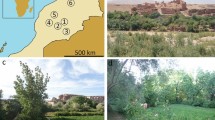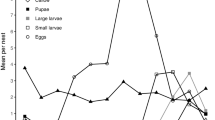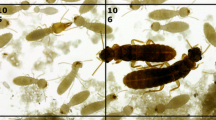Abstract
Species of the subgenus Augochlora have been considered solitary, and their behavior was postulated as a reversal from the social condition known for its closest relatives. In this study, conclusive evidence of eusocial behavior in the wood-dwelling subgenus Augochlora is presented. Direct observation of behavior within artificial nests in the laboratory allowed studying the suite of behaviors that characterize social structure in the species Augochlora (Augochlora) phoemonoe. The following behaviors were recorded and analyzed: locomotion, feeding, construction activities within the nest, pollen collecting, guarding, oviposition, sudden retreats, antennation-tarsation, passing, and following. The last three behaviors represented interactions between nestmates. Social behavior in this temperate South American species is characterized by: a solitary nest initiation phase, followed by an eusocial phase with at least two broods; the small size of the colonies, with 1-3 first-brood females during the summer foraging period; the long-lived foundresses, alive until the end of the season; lack of morphological differentiation between dominant and subordinate individuals, evidenced by size only, but strong physiological differentiation, with a high reproductive skew; short egg-to-adult developmental time (approximately 30 days); and delayed male production to the second or subsequent broods. Indexes of division of labor ranged between 0.32 and 0.76 for the studied nests, indicating behavioral specialization between colony members. During the eusocial phase, daughter bees had the highest frequencies of construction, pollen collection and guarding. Colony integration was mediated by high rates of social interactions, initiated by the foundress.


Similar content being viewed by others
References
Batra SWT (1964) Behavior of the social bee, Lasioglossum zephyrum, within the nest (Hymenoptera: Halictidae). Insect Soc 11:159–186
Brady SG, Sipes S, Pearson A, Danforth BN (2006) Recent and simultaneous origins of eusociality in halictid bees. Proc Roy Soc B 273:1643–1649
Breed MD, Gamboa GJ (1977) Behavioral control of workers by queens in primitively eusocial bees. Science 195:649–696
Coelho BWT (2004) A review of the bee genus Augochlorella (Hymenoptera: Halictidae: Augochlorini). Syst Entomol 29:282–323
Cover TM, Thomas JA (1991) Elements of information theory. Wiley, New York
Dalmazzo M, Roig-Alsina A (2011) Revision of the species of the New World genus Augochlora (Hymenoptera, Halictidae) occurring in the southern temperate areas of its range. Zootaxa 2750:15–32
Dalmazzo M, Roig-Alsina A (2012) Nest structures and notes on social behavior of Augochlora amphitrite (Schrottky) (Hymenoptera: Halictidae). J Hym Res 26:17–29
Danforth BN, Eickwort GC (1997) The evolution of social behavior in the augochlorine sweat bees (Hymenoptera: Halictidae) based on a phylogenetic analysis of the genera. In: Choe JC, Crespi BJ (eds) The evolution of social behavior in insects and arachnids. Cambridge University Press, Cambridge, UK
Eickwort GC (1969) Tribal positions of Western Hemisphere green sweat bees, with comments on their nest architecture (Hymenoptera: Halictidae). Ann Entomol Soc Am 62:652–660
Eickwort GC, Eickwort KR (1969) Aspects of the biology of Costa Rican halictine bees, I. Agapostemon nasutus (Hymenoptera: Halictidae). J Kansas Entomol Soc 42:421–452
Eickwort GC, Eickwort KR (1972) Aspects of the biology of Costa Rican halictine bees, IV. Augochlora (Oxystoglosella). J Kansas Entomol Soc 45:18–45
Eickwort GC, Eickwort KR (1973) Notes on the nests of three wood-dwelling species of Augochlora from Costa Rica. J Kansas Entomol Soc 46:17–22
Engel MS (2000) Classification of the bee tribe Augochlorini (Hymenoptera: Halictidae). Bull Amer Mus Nat Hist 1-90
Gorelick R, Bertram SM, Killeen PR, Fewell JH (2004) Normalized mutual entropy in biology: quantifying division of labor. Am Nat 164:677–682
Greenberg L (1982) Year-round culturing and productivity of sweat bee, Lasioglossum zephyrum (Hymenoptera: Halictidae). J Kansas Entomol Soc 55:13–22
Jeanson R, Kukuk PF, Fewell JH (2005) Emergence of division of labour in halictine bees: contributions of social interactions and behavioural variance. Anim Behav 70:1183–1193
Kapheim KM, Bernal SP, Smith AR, Nonacs P, Wcislo WT (2011) Support for maternal manipulation of developmental nutrition in a facultatively eusocial bee Megalopta genalis (Halictidae). Behav Ecol Sociobiol 65:1179–1190
Lacey EA, Sherman PW (2005) Redefining eusociality: concepts, goals and level of analysis. Ann Zool Fennici 42:573–577
Michener CD (1990) Reproduction and castes in social halictine bees. In: Engels W (ed) Social Insects: An Evolutionary Approach to Castes and Reproduction. Springer, Berlin Heiderbelrg-New York
Michener CD (2007) The bees of the world, 2nd edn. Johns Hopkins University Press, Baltimore
Michener CD, Brothers DJ (1971) A simplified observation nest for burrowing bees. J Kansas Entomol Soc 44:236–239
Michener CD, Brothers DJ (1974) Were workers of eusocial Hymenoptera initially altruistic or oppressed? Proc Nat Acad Sci USA 71:671–674
Michener CD, Wille A (1961) The bionomics of a primitively social bee, Lasioglossum inconspicuum. Univ Kansas Sci Bull 42:1123–1202
Moure JS (2007) Augochlorini Beebe, 1925. In: Moure JS, Urban D, Melo GAR (eds) Catalogue of bees (Hymenoptera Apoidea) in the Neotropical Region. Sociedade Brasilera de Entomología, Curitiba
Ordway E (1966) The Bionomics of Augochlorella striata and A. persimilis in Eastern Kansas (Hymenoptera: Halictidae). J Kansas Entomol Soc 39:270–313
Packer L (1990) Solitary and eusocial nests in a population of Augochlorella striata (Provancher) (Hymenoptera; Halictidae) at the northern edge of its range. Behav Ecol Sociobiol 27:339–344
Packer L (2006) Use of artificial arenas to predict the social organization of halictine bees: Data from fourteen species from Chile. Insect Soc 53:307–315
Purcell J (2011) Geographic patterns in the distribution of social systems in terrestrial arthropods. Biol Rev 86:475–491
Ratnieks FLN, Wenseleers T (2008) Altruism in insect societies and beyond: voluntary or eforced? Trends Ecol Evol 23:45–52
Schwarz MP, Richards MH, Danforth BN (2007) Changing paradigms in insects social evolution: insights from Halictine and Allodapine bees. Ann Rev Entomol 52:127–150
Shannon CE (1948) A mathematical theory of communication. Bell Syst Tech J 27:379–423
Sherman PW, Lacey EA, Reeve HK, Keller L (1995) The eusociality continuum. Behav Ecol 6:102–108
Smith AR, Kapheim KM, O’Donnell S, Wcislo WT (2009) Social competition but not subfertility leads to a division of lavour in the facultatively social sweat bee Megalopta genalis (Hymenoptera: Halictidae). Anim Behav 78:1043–1050
Stockhammer KA (1966) Nesting habit and life cycle of a sweet bee, Augochlora pura. J Kansas Entomol Soc 39:157–192
Tierney SM, Fischer CN, Rehan SM, Kapheim KM, Wcislo WT (2013) Frequency of social nesting in the sweat bee Megalopta genalis (Halictidae) does not vary across a rainfall gradient, despite disparity in brood production and body size. Insect Soc 60:163–172
Wcislo WT, Danforth BN (1997) Secondarily solitary: the evolutionary loss of social behavior. Trends Ecol Evol 12:468–474
Wcislo WT, Gonzalez VH (2006) Social and ecological contexts of trophallaxis in facultatively social sweat bees, Megalopta genalis and M. ecuadoria (Hymenoptera: Halictidae). Insect Soc 53:220–225
Wcislo WT, González VH, Engel MS (2003) Nesting and social behavior of a wood-dwelling Neotropical bee, Augochlora isthmii (Schwarz), and notes on a new species, A. alexanderi Engel (Hymenoptera: Halictidae). J Kansas Entomol Soc 76:588–602
Wcislo WT, Arneson L, Roesch K, Gonzalez V, Smith A, Fernández H (2004) The evolution of nocturnal behavior in sweat bees, Megalopta genalis and M. ecuadoria (Hymenoptera: Halictidae): an escape from competitors and enemies? Biol J Linn Soc 83:377–387
Yanega D (1997) Demography and sociality in halictini bees (Hymenoptera: Halictidae). In: Choe JC, Crespi BJ (eds) The evolution of social behavior in insects and arachnids. Cambridge University Press, Cambridge
Zillikens A, Steiner J, Mihalkó Z (2001) Nest of Augochlora (A.) esox in bromeliads, a previously unknown site for sweat bees (Hymenoptera: Halictidae). Stud Neotrop Fauna Envir 36:137–142
Acknowledgments
We thank Rocío Gonzalez-Vaquero for her invaluable help in bee rearing, Gerónimo Galvani for helping us to make tissue sections with the cryostat, and Lina Horovitz for providing comments on language style. We thank Miriam Richards, Associate Editor, and two anonymous reviewers for their helpful comments that improved the manuscript. This study was supported by grants ANPCyT, Argentina, 2007-1238, and CONICET, Argentina, PIP 2011-0288.
Author information
Authors and Affiliations
Corresponding author
Electronic supplementary material
Below is the link to the electronic supplementary material.
Rights and permissions
About this article
Cite this article
Dalmazzo, M., Roig-Alsina, A. Social biology of Augochlora (Augochlora) phoemonoe (Hymenoptera, Halictidae) reared in laboratory nests. Insect. Soc. 62, 315–323 (2015). https://doi.org/10.1007/s00040-015-0412-8
Received:
Revised:
Accepted:
Published:
Issue Date:
DOI: https://doi.org/10.1007/s00040-015-0412-8




